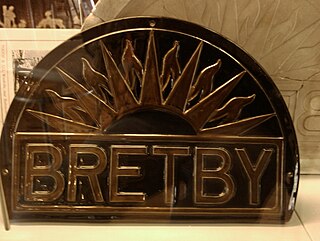
The British Museum is a public museum dedicated to human history, art and culture located in the Bloomsbury area of London. Its permanent collection of eight million works is the largest in the world. It documents the story of human culture from its beginnings to the present. The British Museum was the first public national museum to cover all fields of knowledge.

Middlesbrough is a town in the Middlesbrough unitary authority borough of North Yorkshire, England. The town lies near the mouth of the River Tees and north of the North York Moors National Park. The built-up area had a population of 148,215 at the 2021 UK census. It is the largest town of the wider urban Tees Valley area, which had a population of 678,400 in 2021.

Teesside is a built-up area around the River Tees in North East England, split between County Durham and North Yorkshire. The area contains the towns of Middlesbrough, Stockton-on-Tees, Billingham, Redcar, Thornaby-on-Tees, and Ingleby Barwick. Teesside's economy was once dominated by heavy manufacturing until deindustrialisation in the latter half of the 20th century. Chemical production continues to contribute significantly to Teesside's economy.

Manchester Museum is a museum displaying works of archaeology, anthropology and natural history and is owned by the University of Manchester, in England. Sited on Oxford Road (A34) at the heart of the university's group of neo-Gothic buildings, it provides access to about 4.5 million items from every continent. It is the UK's largest university museum and serves both as a major visitor attraction and as a resource for academic research and teaching. It has around 430,000 visitors each year.

MIMA, or Middlesbrough Institute of Modern Art, is a contemporary art gallery based in the centre of Middlesbrough, England. The gallery was formally launched on Sunday 27 January 2007; since 2014 it has been part of Teesside University.

Middlesbrough is a parliamentary constituency in the United Kingdom, recreated in 1974, and represented since 2012 in the House of Commons of the UK Parliament by Andy McDonald from the Labour Party. An earlier version of the seat existed between 1868 and 1918.

Christopher Dresser was a British designer and design theorist, now widely known as one of the first and most important independent designers. He was a pivotal figure in the Aesthetic Movement and a major contributor to the allied Anglo-Japanese or Modern Style, both of which originated in England and had long-lasting international influence.

Dorman Long & Co was a UK steel producer, later diversifying into bridge building. The company was once listed on the London Stock Exchange.

Acklam is an area in the Borough of Middlesbrough, North Yorkshire, England. It is believed that the settlement is Anglo-Saxon in origin, the name is Old English for "place at the oak clearings" or "place of oaks". Acklam was an ancient parish, being known as West Acklam to distinguish it from Acklam in Ryedale.

Captain Cook Birthplace Museum is a public museum located in Stewart Park in Marton, Middlesbrough within the borough of Middlesbrough and the ceremonial county of North Yorkshire, England. It is one of two institutions managed by Middlesbrough Council, along with the Dorman Museum.

Linthorpe is a suburb of Middlesbrough in the Borough of Middlesbrough, North Yorkshire, England. It contains two wards: Linthorpe with a population of 9,711 and Park with a population of 5,919.

The Anglo-Japanese style developed in the United Kingdom through the Victorian era and early Edwardian era from approximately 1851 to the 1910s, when a new appreciation for Japanese design and culture influenced how designers and craftspeople made British art, especially the decorative arts and architecture of England, covering a vast array of art objects including ceramics, furniture and interior design. Important centres for design included London and Glasgow.

Albert Park is an open access, free public park, located in Middlesbrough, in the borough of Middlesbrough and the ceremonial county of North Yorkshire, England.

Bretby Art Pottery was an art pottery studio founded in 1882 by Henry Tooth and William Ault in Woodville, Derbyshire, where production began on 25 October 1883. Tooth went into partnership with Ault following his successful leadership of the celebrated Linthorpe Pottery in Middlesbrough where he had been recommended as general manager by the designer Dr Christopher Dresser in 1879.

Frank Watson Elgee was a published archaeologist, geologist and naturalist. He wrote several books on the North York Moors such as The Moorlands of North-Eastern Yorkshire (1912), The Romans in Cleveland (1923) and Early Man in North East Yorkshire (1930). In 1933 Leeds University conferred on him an Honorary degree of Doctor of Philosophy.

Middlesbrough started as a Benedictine priory on the south bank of the River Tees, its name possibly derived from it being midway between the holy sites of Durham and Whitby. The earliest recorded form of Middlesbrough's name is "Mydilsburgh", containing the term burgh.

Linthorpe Art Pottery was a British pottery that operated between 1878 and 1890 in Linthorpe, Middlesbrough. It produced art pottery, and is especially known for the early collaboration of the designer Christopher Dresser; many of the early wares have his impressed signature.
Emily Hesse was a multidisciplinary British visual artist, author and activist.

William Ault was an English potter, involved with a number of companies in the Staffordshire potteries and South Derbyshire making art pottery and more utilitarian wares.
Middlesbrough Cricket Club plays at Acklam Park in Middlesbrough, North Yorkshire, England. The club currently plays in the North Yorkshire and South Durham Cricket League (NYSD).























